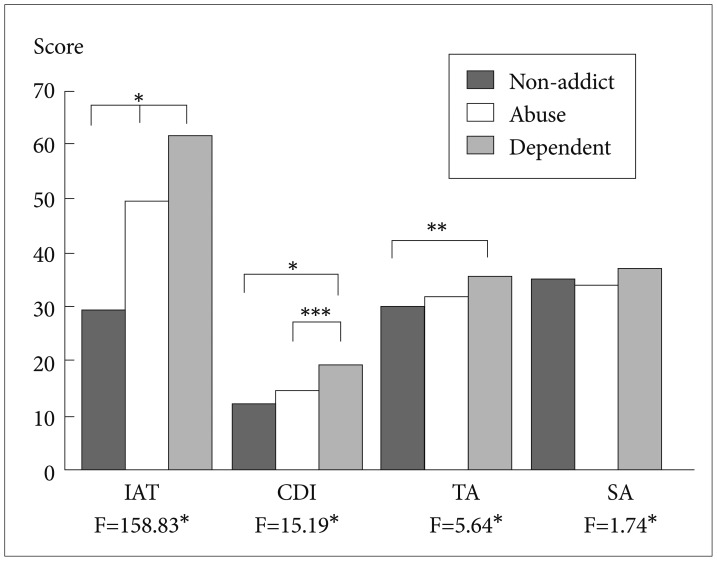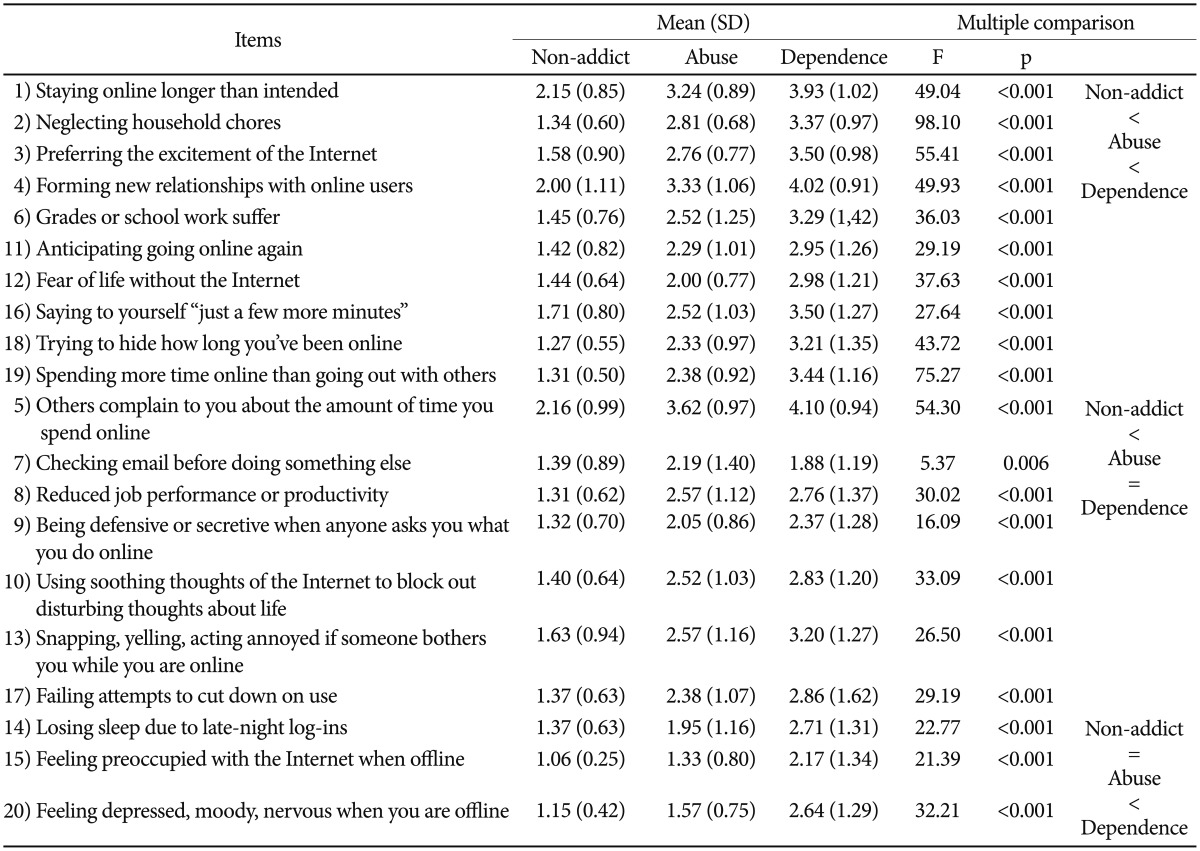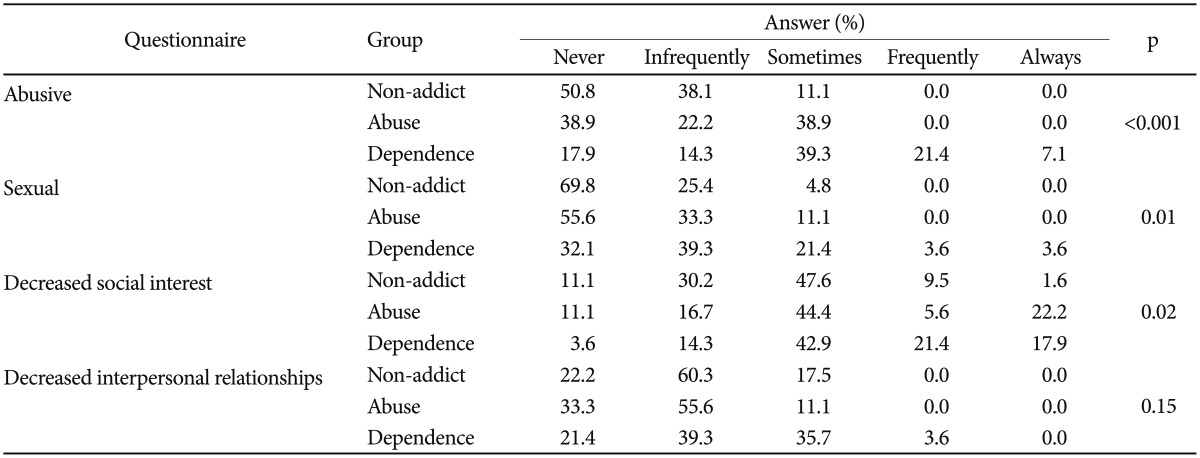 |
 |
- Search
| Psychiatry Investig > Volume 11(4); 2014 > Article |
Abstract
Objective
This study examined the differences in psychiatric comorbidities and behavioral aspects in accordance with the severity of Internet addiction in male adolescents.
Methods
One hundred and twenty-five adolescents from four middle and high schools in Seoul were enrolled in this study. The subjects were divided into non-addict, abuse, and dependence groups according to a diagnostic interview by psychiatrists. The psychiatric comorbidities and behavioral aspects of subjects were evaluated through psychiatric clinical interviews based on the Diagnostic and Statistical Manual of Mental Disorders (4th edition), the Children's Depression Inventory, the State-Trait Anxiety Inventory, the Internet Addiction Test, and a self-reported questionnaire about behavioral aspects.
Results
The psychiatric comorbidity distributions were significantly different in the abuse and dependence groups, particularly in terms of attention-deficit hyperactivity disorder and mood disorder items. The Children's Depression Inventory, the State-Trait Anxiety Inventory, and the Internet Addiction Test scores were also significantly different among the three groups. There were significant differences in 10 of the 20 items of the Internet Addiction Test between the non-addict, abuse, and dependence groups. There were significant differences in seven items between the non-addict and abuse groups, but no differences between subjects in the abuse and dependence groups. Significant differences were observed in three items between the abuse and dependence groups, but there were no significant differences between the non-addict and abuse groups. In terms of behavioral aspects, scores for abusive, sexual, and decreased social interest behaviors were highest in the dependence group, and lowest in the non-addict group. However, the behavioral aspects of decreased interpersonal relationships did not show this difference between groups.
To date, there are no clear definitions of Internet addiction, and Internet addiction as a distinct entity within the topic of addictive disorders continues to be a subject of debate. Although there are several criteria and tests for Internet addiction, the Internet Addiction Test (IAT) developed by Young1 is the most widely-used assessment tool. The IAT is based on the criteria for pathological gambling described in the Diagnostic and Statistical Manual of Mental Disorders, 4th edition (DSM-IV),2 suggesting that Internet addiction is a form of behavioral addiction.
Several studies have shown that behavioral and substance addictions have many similarities in diverse aspects.3 To evaluate Internet addiction, Anderson and Fortson used modified criteria in a study modeled after the substance-related disorders from the DSM-IV, to evaluate Internet addiction.4,5 Using these criteria, Internet addiction is defined as an addictive disorder similar to substance use disorders. Their research implied that, as in cases of substance abuse, Internet addiction may be differentially diagnosed as either abuse or dependence, with distinctive clinical characteristics. However, because that study did not conduct patient interviews, but rather made a diagnosis based on paper surveys, the authors were not able to determine exact psychiatric comorbidities for each patient.
A wealth of research regarding Internet addiction has focused on the psychiatric symptoms and psychiatric comorbidities of the condition.6,7,8 There have been consistent findings regarding the relationship between depressive symptoms and Internet addiction,8,9,10,11 and many researchers have reported that a range of psychiatric diseases coexist with Internet addiction.12,13 An accurate assessment of comorbidity is an essential part of understanding the etiology of Internet addiction, because it is obvious that Internet addiction and psychiatric comorbidity affect each other even though their causal relationship remains unclear. Clinically, accurate assessment of comorbidity is important for appropriate treatment, as well as to predict the prognosis of addicts. Recent studies have indicated that Internet addiction has heterogeneous features in psychiatric comorbidities and behavioral aspects according to gender, age, and the severity of addiction.9,14 However, these have been small-scale studies or studies that used only self-reported questionnaires without diagnostic interviews by psychiatrists. If it is clear that abuse and dependence group is showing the difference in terms of psychiatric comorbidities based upon accurate diagnosis by psychiatrists, we will be able to plan the research and therapeutic approach for internet addiction more precisely.
Based on the criteria provided by Fortson,4 the current study aims to distinguish Internet abuse and dependence by conducting diagnostic interviews, and to determine the differences between the two groups in terms of psychiatric comorbidities and behavioral aspects. The authors hypothesized that there are differences in psychiatric comorbidities and behavioral aspects between male adolescents with tendencies of Internet abuse and dependence.
Data were obtained from four local middle and high schools. Included in this study were subjects who were identified as Internet addicts both by IAT scores over 401,15,16 as well as by psychiatric diagnosis. Age- and gender-matched subjects who were identified as non-addicts were included as the control group. For the non-addict group, diagnostic interviews about Internet addiction and questionnaires were conducted, but psychiatric comorbidities of subjects were not evaluated in this group. The subjects and their parents provided written informed consent after receiving a full explanation of the study, in accordance with procedures approved by the Institutional Review Board of Seoul St. Mary's Hospital.
The degree of Internet use was assessed by two methods. First, all participants took the IAT. The IAT is a 5-point Likert scale composed of 20 items, with each item rating the degree of preoccupation, compulsive use, behavioral problems, emotional changes, and impact on general functioning related to Internet use.1 A higher score indicates a more severe Internet addiction. Second (and the more important part in this study), five psychiatrists conducted interviews using a modified version of the substance abuse and dependence criteria in the DSM-IV. Our criteria for Internet abuse and dependence are shown in Table 1.
Psychiatrists assessed the psychiatric comorbidity of subjects with the Structured Clinical Interview for Diagnostic and Statistical Manual of Mental Health Disorders-IV (SCID). In addition, all subjects performed the Korean version of the Children's Depression Inventory (CDI)17 and the State-Trait Anxiety Inventory (STAI)18 for objective assessment of the severity of comorbidities.
Internet addiction research typically uses a 40-item self-reported questionnaire about Internet usage.19 In this study, four items related to behavioral aspects were added to the questionnaire for additional analysis: 1) Are you becoming more aggressive in the cyber world? (abusive), 2) Are your conversations in the cyber world more sexual in nature? (sexual), 3) Are you interested in your school life? (decreased social interest), 4) What is your relationship with friends? (decreased interpersonal relationship)
All four items were rated on a 5-point Likert scale.
Table 2 lists demographic data about the subjects. In the addict group, 21 and 41 subjects were classified as belonging to the Internet abuse group and Internet dependence group, respectively.
Several psychiatric comorbidities were identified among the Internet addicts. In the total addict group, the most common comorbidity was depressive disorder (38.7%), followed by attention-deficit hyperactivity disorder (35.5%), mood disorders other than depressive disorder (12.9%), anxiety disorder (8.1%), substance use disorder (4.8%), impulse control disorder (4.8%), and other (14.5%). When the addict group was subdivided into abuse and dependence groups, there were further differences in the frequency of comorbidities between the two groups (Table 3). The total comorbidity rate was higher in the dependence group (82.9%) than in the abuse group (81.0%), but the difference was not statistically significant. The only significant difference between the two groups was in the frequency of attention-deficit hyperactivity disorder. The combination of depressive disorder and other mood disorders into a single category of "mood disorders", revealed a significant difference between the two groups as attention-deficit hyperactivity disorder (Figure 1).
Figure 2 shows the differences in CDI, trait anxiety, state anxiety, and IAT scores between the groups. The CDI, trait anxiety, and IAT scores increased in the order of non-addict, abuse, and dependence groups, but the state anxiety scores did not. There were significant differences between each group in the CDI items regarding negative thoughts of self and the future, low self-esteem, suicidal ideation, insomnia, loss of appetite, loss of interest in activities, and difficulty with peer relationships. In particular, there were significant differences in low self-esteem, negative thoughts of the future, and suicidal ideation between the abuse and dependence groups.
Responses to 10 of the 20 IAT items showed significant differences among the non-addict, abuse, and dependence groups. Seven items were significantly different between the non-addict and abuse groups, but not between the abuse and dependence groups. On the other hand, for three items, there were significant differences in the responses of the abuse and dependence groups, but not between the non-addict and abuse groups (Table 4).
Three items regarding abusive, sexual, and decreased social interest were significantly different between the three groups. However, responses regarding decreased interpersonal relationships were not significantly different (Table 5).
The results of the present study suggest that there are differences in psychiatric comorbidities between subjects in the Internet abuse and dependence groups. In the dependence group, mood disorders, particularly depressive disorder, were a more common comorbidity than attention-deficit hyperactivity disorder. On the other hand, in the abuse group, attention-deficit hyperactivity disorder was the most common comorbid disorder. Core symptoms of attention-deficit hyperactivity disorder are "being easily bored" and "having an aversion to delayed rewards."20,21 Internet behavior is characterized by rapid response and immediate rewards, possibly reducing feelings of boredom or providing immediate stimulation and rewards for subjects with attention-deficit hyperactivity disorder. The Internet also offers social support, potential achievement, the pleasure of control, and a virtual world in which adolescents can escape from emotional difficulty in the real world.22,23,24 Accordingly, it appears reasonable that depressive adolescents are more likely to use the Internet to alleviate depression, and that they may suffer more deleterious effects from heavy Internet use. This creates a vicious cycle that may lead to a state of dependence on the Internet falling within the spectrum of Internet addiction.25
The significant differences in the CDI and STAI scores among the non-addict, abuse, and dependence groups suggest that subjects in the three groups have different levels of depression and anxiety. However, the causality between depression, anxiety, and Internet addiction has not been identified in this study.
20 items of the IAT could subdivided into three groups, according to differences in scores of non-addict, abuse, and dependence. The three subgroups of the IAT indicate that some items are able to identify each stage of addiction (although some items may be useful only for identifying normal or addict subjects), whereas some items are able to identify the level of dependence in subjects. In this study, sleep disorders, mood changes, and preoccupation were prominent in the dependence group, but there were no significant differences in these items between the non-addict and abuse groups.
Abusive behavior, sexual behavior, and decreased social interest were more severe in the abuse group than in the non-addict group, and were most severe in the dependence group. These results are consistent with the results of previous studies.26,27,28 Decreased interpersonal relationships, however, did not show the same pattern as the other behavioral aspects. It appears that subjects in the abuse group have better relationships with others than subjects in the non-addict group. This could be explained in two ways. First of which, the survey did not differentiate the terms 'on-line' friends and' off-line' friends and this resulted in the expansion of the term. In order to clarify this, we will have to clearly distinguish the term, 'off-line' friends from 'on-line' friends before the evaluation. Secondly, this also may be explained by previous reports suggesting that the Internet tends to compensate for the communication difficulties of introverted and withdrawn people.29 Information regarding an individual's level of interpersonal relationships before the individual demonstrates characteristics of Internet abuse or dependence should be acquired to accurately assess the effect of the Internet on interpersonal relationships.
This study has some limitations. The first limitation is that the psychiatric comorbidities of subjects in the non-addict group were not evaluated. Due to this limitation, our results do not show the differences in psychiatric comorbidities between the non-addict and addict groups. This point, however, does not detract from the primary purpose of comparing psychiatric comorbidities between Internet abuse and dependence groups. The second limitation is that this study was conducted as a cross-sectional study. A longitudinal prospective study is needed to identify the causality of Internet addiction and psychiatric comorbidities.
In conclusion, there are differences in psychiatric comorbidities and behavioral aspects between male adolescents with tendencies of Internet abuse and dependence. These findings suggest that Internet abuse and dependence have a different core psychopathology. Based on these results, in the future research, we will be able to conduct a large-scale study about the biological and psychological mechanism of internet abuse and dependence. And, in terms of the treatment point of view, if the causality of psychiatric comorbidity is found in internet abuse and dependence group, it will be able to help to prevent the recurrence or worsening of it.
Acknowledgments
The study was supported by a grant from the Korean Health Technology R&D Project, Ministry of Health and Welfare, Republic of Korea (HI12 C0113(A120157)).
References
1. Young KS. Caught in the Net: How to Recognize the Signs of Internet Addiction and a Winning Strategy for Recovery. New York: John Wiley & Sons, Inc.; 1998.
2. American Psychiatric Association. Diagnostic and statistical manual of mental disorders. Fourth Edition. Washington, DC: American Psychiatric Press; 1994.
3. Grant JE, Marc NP, Aviv W, David AG. Introduction to behavioral addiction. Am J Drug Alcohol Abuse 2010;36:233-241. PMID: 20560821.



4. Fortson BL, Scotti JR, Chen YC, Malone J, Del Ben KS. Internet use, abuse, and dependence among students at a southeastern regional university. J Am Coll Health 2007;56:137-144. PMID: 17967759.


5. Anderson KJ. Internet use among college students: an exploratory study. J Am Coll Health 2001;50:21-26. PMID: 11534747.


6. Black DW, Belsare G, Schlosser S. Clinical features, psychiatric comorbidity, and health-related quality of life in persons reporting compulsive computer use behavior. J Clin Psychiatry 1999;60:839-844. PMID: 10665630.


7. Shapira NA, Goldsmith TD, Keck PE Jr, Khosla UM, McElroy SL. Psychiatric features of individuals with problematic internet use. J Affect Disord 2000;57:267-272. PMID: 10708842.


8. Young KS, Rogers RC. The relationship between depression and Internet addiction. Cyberpsychol Behav 1998;1:25-28.

9. Petrie H, Gunn D. Internet "Addiction": the Effects of Sex, Age, Depression and Introversion In: British Psychological Society London Conference; Dec 15-16, 1998; London, England.
10. Ha JH, Kim SY, Bae SC, Bae S, Kim H, Sim M, et al. Depression and internet addiction in adolescents. Psychopathology 2007;40:424-430. PMID: 17709972.


11. Kim K, Ryu E, Chon MY, Yeun EJ, Choi SY, Seo JS, et al. Internet addiction in Korean adolescents and its relation to depression and suicidal ideation: a questionnaire survey. Int J Nurs Stud 2006;43:185-192. PMID: 16427966.


12. Ha JH, Yoo HJ, Cho IH, Chin B, Shin D, Kim JH. Psychiatric comorbidity assessed in Korean children and adolescents who screen positive for Internet addiction. J Clin Psychiatry 2006;67:821-826. PMID: 16841632.


13. Yoo HJ, Cho SC, Ha J, Yune SK, Kim SJ, Hwang J, et al. Attention deficit hyperactivity symptoms and Internet addiction. Psychiatry Clin Neurosci 2004;58:487-494. PMID: 15482579.


14. Ko CH, Yen JY, Chen CC, Chen SH, Yen CF. Gender differences and related factors affecting online gaming addiction among Taiwanese adolescents. J Nerv Ment Dis 2005;193:273-277. PMID: 15805824.


15. Laura W, Marry M. The psychometric properties of the internet addiction test. Cyberpsychol Behav 2004;7:443-450. PMID: 15331031.


16. Panayiotis P, Miranda JW. Evaluation of the psychometric properties of the Internet Addiction Test in a sample of Cypriot high school students. Eur J Psychol 2012;8:327-351.

17. Cho SC. Development of the Korean form of the Kovacs' Children's Depression Inventory. J Korean Neuropsychiatr Assoc 1990;29:943-956.
18. Spielberger CD, Gorsuch RL, Lushene RE. Manual for the State-Trait Anxiety Inventory. Palo Alto: Consulting Psychologist Press; 1970.
19. Kim CT, Kim DI, Park JK. A Study on Internet Addiction Counseling and the Development of Prevention Program. Seoul: National IT Industrial Promotion Agency; 2002.
20. Castellanos FX, Tannock R. Neuroscience of attention-deficit/hyperactivity disorder: the search for endophenotypes. Nat Rev Neurosci 2002;3:617-628. PMID: 12154363.


21. Diamond A. Attention-deficit disorder (attention-deficit/hyperactivity disorder without hyperactivity): a neurobiologically and behaviorally distinct disorder from attention-deficit hyperactivity disorder (with hyperactivity). Dev Psychopathol 2005;17:807-825. PMID: 16262993.



22. Suler JR. To get what you need: healthy and pathological Internet use. Cyberpsychol Behav 1999;2:385-393. PMID: 19178210.


23. Tichon JG, Shapiro M. The process of sharing social support in cyberspace. Cyberpsychol Behav 2003;6:161-170. PMID: 12804028.


24. Leung L. Net-generation attributes and seductive properties of the Internet as predictors of online activities and Internet addiction. Cyberpsychol Behav 2004;7:333-348. PMID: 15257834.


25. Kraut R, Kiesler S, Boneva B, Cummings J, Helgeson V, Crawford A. Internet paradox revisited. J Soc Issues 2002;58:49-74.

26. Kim EJ, Namkoong K, Ku T, Kim SJ. The relationship between online game addiction and aggression, self-control and narcissistic personality traits. Eur Psychiatry 2008;23:212-218. PMID: 18166402.


27. Ko CH, Yen JY, Liu SC, Huang CF, Yen CF. The associations between aggressive behaviors and Internet addiction and online activities in adolescents. J Adolesc Health 2009;44:598-605. PMID: 19465325.


28. Cooper A, Scherer CR, Boies SC, Gordon BL. Sexuality on the Internet: from sexual exploration to pathological expression. Prof Psychol Res Pract 1999;30:154-164.

29. Allison SE, von Whalde LV, Shockley T, Gabbard GO. The Development of the Self in the Era of the Internet and Role-Playing Fantasy Games. Am J Psychiatry 2006;163:381-385. PMID: 16513856.


Figure┬Ā1
Comorbidities of Internet abuse and dependence groups. Fisher's exact test was used for statistical comparisons. ADHD: attention-deficit hyperactivity disorder.

Figure┬Ā2
Differences in the CDI, TA, SA and IAT scores between the non-addict, abuse, and dependence groups. ANOVA with post hoc multiple comparisons and Bonferroni adjustments was used for analysis. *p<0.001, **p<0.01, ***p<0.05. IAT: internet addiction test, CDI: the Children's Depression Inventory, TA: trait anxiety, SA: state anxiety, ANOVA: analysis of variance.












